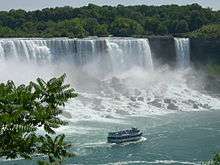Niagara Falls
Niagara Falls is a popular, though often tacky and touristy honeymoon destination on the USA-Canada border, approximately midway between Lake Erie and Lake Ontario.

The region is divided by the border between the Canadian province of Ontario and the US state of New York. There are a pair of twin cities, one on each side of the boundary:
- Niagara Falls (Ontario) in Canada's Niagara Region
- Niagara Falls (New York) in the United States of America's western New York Niagara County
Other parts of the region are:
- Three waterfalls (the Horseshoe Falls, the American Falls and the Bridal Veil Falls) and a group of islands (Goat Island and Luna Island are the largest) straddle the international boundary and form the southern end of the Niagara Gorge.
- The Niagara River, which leads from Buffalo over the falls and downstream to Lewiston-Queenston and Niagara-on-the-Lake.
The international boundary runs approximately through the middle of the Horseshoe Falls, the largest of the three. Despite this, the Horseshoe Falls are often called the "Canadian Falls". The American Falls, the Bridal Veil Falls and the two islands are in the USA. See the individual city articles Niagara Falls (Ontario) and Niagara Falls (New York) for local listings for each side.

With four to six million cubic feet (168,000 m³) of water falling every minute, the combined falls form the highest flow rate of any waterfall in the world. Horseshoe Falls is the most powerful waterfall in North America, based on its exceptionally-high flow rate and a vertical drop of more than 165 feet (50 m). While not exceptionally high, the Niagara Falls are very wide. Renowned for their beauty, they serve as a huge source of hydroelectric power and are well illuminated at night.
Niagara serves as gateway to attractions in the surrounding Niagara Region, including wineries and the Shaw Festival at Niagara-on-the-Lake.
There are two road bridges at Niagara Falls, plus one at Lewiston-Queenston and one in Buffalo; these four crossings are usually very busy as they serve Toronto.
By motorcar, Niagara is a relatively easy day trip from Toronto (75 miles, 121 km) or Buffalo (17 miles, 27 km). By rail, it was one of the few places where a bridge could carry a locomotive across the Canadian border during the Underground Railroad era of the 1850s; Amtrak/VIA still use Niagara as a rail border crossing for passengers from New York City on the "Maple Leaf" to Toronto. "GO" commuter trains on the Oshawa-Toronto-Hamilton "Lakeshore" mainline are extended to Niagara on weekends in high season, but do not cross the border.